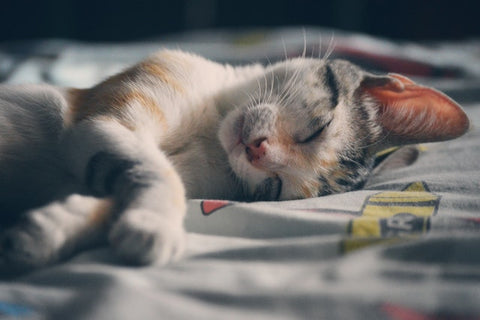What is feline infectious peritonitis (FIP) in cats?

You might not have ever heard of feline infectious peritonitis, because it’s not a particularly common cat disease.[1] And this is one of those times when ignorance is bliss.
Feline infectious peritonitis, also known as FIP, is one of the strangest, least understood of all cat illnesses.[2] It starts out as a common infection that doesn’t cause serious disease in most cats. But if the virus that causes the infection mutates, the illness that follows is almost invariably fatal.
There is no approved cure for FIP, but there is hope out there for some cats in the form of an unapproved antiviral treatment. Desperate cat guardians may find themselves shopping on the black market and paying exorbitant prices for this potentially lifesaving drug.
The purpose of this post is to explain what we currently know about FIP in cats and to share some information about this unapproved treatment.
What causes FIP in cats?

FIP is related to feline coronavirus. Coronaviruses, as many of us now know, are a common kind of virus that typically infects the nose and throat or gastrointestinal tract in humans and animals.
COVID-19 is a kind of coronavirus, but the feline coronavirus that leads to FIP is not the same virus. The feline coronavirus only infects cats.
How common is feline coronavirus?
Feline coronavirus is extremely common. Some say that up to 50% of “single” cats (who don’t live with another cat) have had the virus at some point, while 80-90% of cats who live in multi-cat environments will have had feline coronavirus during their lifetimes.
Most of these infected cats, at least 90%, will not go on to have FIP and will remain healthy.[3]
What happens to cats who get feline coronavirus?

Most cats who get feline coronavirus experience an infection in their gastrointestinal tract, which is called feline enteric coronavirus (FeCV). The word “enteric” just means that it occurs in the intestines.
Most cats who get FeCV don’t show any signs of illness. At worse, a cat may have some diarrhea or mild upper respiratory symptoms. They get better and their cat guardians may be none the wiser.[4]
But in some cases, somewhere between 5% and 10%, the virus mutates. The mutated virus, called FIPV, enters a cat’s white blood cells and the disease begins to spread throughout the cat’s body.[5], [6]
How does the mutated virus cause FIP?
FIP is what happens when a cat’s body responds to these FIPV-infected white blood cells.[7]
A cat’s immune system causes an intense inflammatory response to this infection. It’s this inflammation – usually in the belly, kidney, or brain, where the white blood cells find themselves – that causes the symptoms of FIP.
What is the prognosis for a cat with FIP?
Once a cat has FIP, he doesn’t typically get better. The disease progresses and is almost always fatal, frequently within days of diagnosis.
Some recently developed therapies may help, but they are not currently FDA-approved.[8] See more on this topic below.
How do cats become infected?

Cats are typically exposed when their mouths have contact with poop containing feline coronavirus. About one third of cats who have coronavirus have virus in their feces and pass the disease onto other cats this way.
Most cats who are infected only shed the virus in their poop for a few months. Some continue to shed virus at a lower level, possibly on and off, for up to two years. Some cats will shed virus their whole lives.[9]
Cats can also catch feline coronavirus by breathing it in, by sharing a food bowl or litter box with an infected cat, and through close contact with a sick cat, including grooming. It’s also believed that a pregnant mother cat could pass it to her unborn kittens.[10]
The virus itself isn’t very sturdy. It only survives for 24-36 hours outside of a cat’s body, although there is some thought that it will survive a lot longer in a cold or very dry environment.[11],[12]
What happens after a cat is infected with feline coronavirus?
Sometimes, nothing happens for a long time after a cat is infected with feline coronavirus. The virus can remain inactive for months before a cat gets sick.
Even then, most cats who finally develop coronavirus don’t get FIP. They have an immune response, like they’re supposed to, and move on with their lives. Only a small portion of cats go on to get FIP.
Are some cats more likely than others to get FIP?

Most cats are exposed to feline coronavirus when they are young.
Younger cats are at greatest risk of developing FIP. 70% of FIP cases are in cats that are less than a year and a half old. Half of all of the cases of FIP are in cats who are less than seven months old.[13]
But cats of any age can get FIP, and elderly cats are at special risk, too.[14]
Cats living in certain circumstances are also more likely to get FIP than other cats, including cats who are living with a lot of other cats, at shelters and catteries.
Male cats seem to be more susceptible than female cats, and purebred cats are more likely than mixed-breed cats to get FIP.[15]
Certain cat breeds are more susceptible than others, including Abyssinian, Bengal, Birman, Himalayan, Ragdoll,[16] Persian, and Rex breeds,[17] such as Devon Rex and Cornish Rex.
Cats who are under stress due to surgery, other infections, or from being rehomed, are more susceptible to FIP. Cats with compromised immune systems are more likely to develop FIP. It’s believed there may be genetic factors at play as well.[18]
What are the symptoms of coronavirus and FIP?

When a cat is initially exposed to coronavirus, there may not be any obvious symptoms: maybe a little sneezing, watery eyes, nasal discharge, or mild diarrhea. A cat guardian will likely be unaware that this infection has even occurred.
Cats who get FIP don’t necessarily get it right after their coronavirus infection. FIP can occur weeks, months, or even years after that initial coronavirus infection.[19]
When FIP does show up, the signs aren’t always crystal clear. They’re what a veterinarian might call “non-specific” or vague symptoms, such as loss of appetite, weight loss, lethargy, apparent depression, and a fever that comes and goes.
Other cats might eventually develop more worrisome symptoms, like seizures, paralysis, and problems with balance or coordination. Some cats develop bleeding or pus in the eyes, or even blindness. You may notice personality changes in your cat, or that she is more sensitive to your touch.[20], [21]
How a cat experiences this disease will be related to the organs that are involved and become inflamed. Different body systems could be affected, including the central nervous system, liver, kidneys, pancreas, intestines, and eyes.
There are two types of FIP: wet and dry

There are actually two forms of FIP in cats: wet, also known as effusive, and dry, also known as non-effusive.
Most cats get the wet kind, but one kind can evolve into the other kind. Wet can become dry and dry can become wet. [22], [23]
The wet or effusive form is exactly what it sounds like. Fluid accumulates in a cat’s body cavities, especially the belly and chest. This can be obvious even to you: a cat might start to look pot-bellied. Extra fluid in the chest can make it hard for a cat to breathe normally.[24]
The dry or non-effusive from is not associated with all that fluid buildup, and tends to develop more slowly than the wet form. The symptoms of this form are from severe inflammation in one of the cat’s body symptoms, as described above. Some cats only have symptoms in their eyes. [25], [26], [27]
How is FIP diagnosed?

There is no definitive test for FIP in cats.
Veterinarians can measure the antibodies to coronavirus in a cat’s blood, but they can’t tell whether they are antibodies to ordinary feline coronavirus, FeCV, or the mutated virus, FIPV. If a cat gets a positive antibody test, it only means he has been exposed to coronavirus, like most other cats in the world.[28]
Cats who have suppressed immune systems might not even test positive for coronavirus antibodies, because their immune systems can’t even produce them. But that wouldn’t mean they don’t have FIP.[29]
The problem is that most of the symptoms of FIP could be some other disease. This makes FIP extremely difficult to diagnose, and often, the diagnoses only comes when everything else is ruled out.
Your vet may order X-rays or an ultrasound to look for fluid in your cat’s chest or abdomen. An analysis of this fluid can be helpful in making a diagnosis because there aren’t many other diseases that result in this kind of fluid buildup.[30]
Your vet may recommend one of several tests that can, in theory, test for the FIPV virus. These might include an immunoperoxidase test, an immunofluorescence test, or a PCR test. But each of these tests have limitations and can lead to false-positive or false-negative results.
How can I prevent my cat from getting FIP?

The only way to truly prevent a cat from getting FIP, is to prevent the cat from contracting feline coronavirus in the first place. This may be difficult, if not impossible, as feline coronavirus is very contagious and many cats are exposed when they are very young, some, possibly, before they are even born.
There is an FIP vaccine available, but it is of questionable effectiveness. Currently, the American Association of Feline Practitioners’ Feline Vaccine Advisory Panel does not routinely recommend it. The vaccine is believed to be safe, however, and cat guardians should work with their veterinarians to help them decide whether or not to administer it to their cat.[31]
The main problem with the vaccine is that most cats have already been infected by the time they are old enough to be vaccinated.[32]
One of the best things you can do for your cat is to prevent her from getting other diseases that challenge her immune system. Keep your cat up-to-date on her other vaccines, including feline leukemia virus (FeLV) and feline calicivirus.[33]
Can humans or dogs get feline coronavirus?
No, coronaviruses cannot be passed from infected cats to humans.[34]
Feline coronavirus is not contagious to dogs.[35]
Should I worry about the other cats in my house?
It is likely that the other cats in your home have already been infected with feline coronavirus, because they have all already been sharing litter boxes, food and water bowls, and have been grooming each other.
Cats from the same household will already have some immunity to feline coronavirus, or they will also be in the early stages of developing FIP, but exposing them further to each other will not make a difference.[36]
Is FIP painful?
Cats who are suffering from FIP do not appear to be in any pain. They appear exhausted, the way someone suffering from the flu might look.[37]
How is FIP in cats treated?
Until recently, FIP in cats was considered incurable and non-treatable.
Some cats only live days to weeks after diagnoses, especially cats who are younger when diagnosed, and who have the wet form of the disease. In fact, the median survival after diagnoses is only around nine days.[38]
Cats who are older, and who have the non-effusive form could live for months. One researcher believes that a Birman cat he worked with, who died at age six from FIP, may have had a low level of the disease for its entire life.[39]
The use of GS-441524 and Remdesivir in FIP

Dr. Niels Pedersen, professor emeritus at the University of California Davis School of Veterinary Medicine, was studying coronaviruses in cats for 50 years before the word “coronavirus” became part of our everyday lexicon. His research on an anti-viral compound called GS-441524[40] contributed to the development of Remdesivir, one of the few treatments available to human sufferers of COVID-19.
GS-441524 and Remdesivir, which are nearly identical, were both invented and are owned by California-based Gilead Sciences. GS-441524 was intended to be a treatment for Ebola, but wasn’t very effective and was shelved.
Dr. Pedersen got permission to use GS-441524 for his research in cats with FIP. He discovered that nearly all cats with the wet form of the disease appeared cured when treated with GS-441524, although the response in “dry” cases has not been as favorable.[41]
Unfortunately, Gilead has, so far refused to license GS-441524 for use in cats.[42]
Cat guardians go to great lengths to save their cats

Cat guardians have been forced to turn to the black market to procure this drug for their dying cats. Because there is no oversight of these sources of GS-441524, purchasers have no guarantee of the concentration and purity of the drug they receive.[43]
The price of a pharmaceutical acquired illicitly can also vary widely. One cat guardian admitted to ABC News in 2020 that she expected to spend $8,000-10,000 on a full course of black-market-obtained treatment for her cat.[44]
Several Facebook support groups, including FIP Warriors, have sprung up to help cat guardians who are facing this tragedy find treatments for their cats.
Where treatment for FIP stands today

Remdesivir was finally approved in the United Kingdom for treatment of FIP in cats in August 2021. GS-441524 is also being manufactured in the U.K. and is available for treatment of cats. This publication has more information:
An update on treatment of FIP in the U.K.
There’s also an email advice hotline (fipadvice@gmail.com) for U.K. residents.
Anivive Lifesciences, an animal health company, is seeking FDA approval for GC37, a compound developed by Dr. Pedersen and another scientist, that is showing even greater promise in treating wet FIP.
To read more about Dr. Pedersen and his work, and to keep up to date on the latest news on FIP treatments, visit Sock It To FIP, Dr. Pedersen's non-profit organization dedicated to eliminating FIP.
Love Pinterest? Here's a Pinterest-friendly pin for your boards!

Dawn LaFontaine
Dawn LaFontaine is a lifelong animal lover who always seems to have a little pet hair in her keyboard. Her blog, Kitty Contemplations, helps cat guardians better understand and care for the special beings they share their lives and homes with. Her cat-products business, Cat in the Box, sells beautiful, well-made, and award-winning products that she designed to meet the biological needs of cats.
_______________
FOOTNOTES
[1] “Feline Infectious Peritonitis: VCA Animal Hospitals.” Vca, https://vcahospitals.com/know-your-pet/feline-infectious-peritonitis.
[2] ibid.
[3] ibid.
[4] “Feline Infectious Peritonitis.” Cornell University College of Veterinary Medicine, 16 Nov. 2022, https://www.vet.cornell.edu/departments-centers-and-institutes/cornell-feline-health-center/health-information/feline-health-topics/feline-infectious-peritonitis.
[5] ibid.
[6] “Feline Infectious Peritonitis (FIP) in Cats.” PetMD, https://www.petmd.com/cat/conditions/infectious-parasitic/c_ct_feline_infectious_peritonitis.
[7] “Feline Infectious Peritonitis.” Cornell University College of Veterinary Medicine.
[8] ibid.
[9] Gallagher, Alex. “Feline Enteric Coronavirus - Digestive System.” Merck Veterinary Manual, Merck Veterinary Manual, 23 Feb. 2023, https://www.merckvetmanual.com/digestive-system/diseases-of-the-stomach-and-intestines-in-small-animals/feline-enteric-coronavirus.
[10] Levy, Julie K., and Staci Hutsell. “Feline Infectious Peritonitis (FIP) - Cat Owners.” Merck Veterinary Manual, Merck Veterinary Manual, 10 Nov. 2022, https://www.merckvetmanual.com/cat-owners/disorders-affecting-multiple-body-systems-of-cats/feline-infectious-peritonitis-fip.
[11] “Feline Infectious Peritonitis: VCA Animal Hospital.
[12] Gallagher.
[13] “Feline Infectious Peritonitis.” Cornell University College of Veterinary Medicine.
[14] “Feline Infectious Peritonitis: VCA Animal Hospital.
[15] “Feline Infectious Peritonitis.” Cornell University College of Veterinary Medicine.
[16] “Feline Infectious Peritonitis: VCA Animal Hospital.
[17] Levy.
[18] “Feline Infectious Peritonitis: VCA Animal Hospital.”
[19] “Feline Infectious Peritonitis.” Cornell University College of Veterinary Medicine.
[20] “Feline Infectious Peritonitis (FIP) in Cats.” PetMD.
[21] Levy.
[22] “Feline Infectious Peritonitis.” Cornell University College of Veterinary Medicine.
[23] “Feline Infectious Peritonitis: VCA Animal Hospital
[24] “Feline Infectious Peritonitis.” Cornell University College of Veterinary Medicine.
[25] ibid.
[26] “Feline Infectious Peritonitis: VCA Animal Hospital.
[27] “Feline Infectious Peritonitis (FIP) in Cats.” PetMD.
[28] “Feline Infectious Peritonitis.” Cornell University College of Veterinary Medicine.
[29] ibid.
[30] “Feline Infectious Peritonitis: VCA Animal Hospital.
[31] “Feline Infectious Peritonitis.” Cornell University College of Veterinary Medicine.
[32] “Feline Infectious Peritonitis (FIP) in Cats.” PetMD.
[33] “Feline Infectious Peritonitis.” Cornell University College of Veterinary Medicine.
[34] ibid.
[35] “Feline Infectious Peritonitis (FIP) in Cats.” PetMD.
[36] Addie, Diane D. “Feline Infectious Peritonitis: Answers to Frequently Asked Questions Concerning FIP and Coronavirus.” Veterinary Nursing Journal, Taylor & Francis, 23 July 2019, https://www.ncbi.nlm.nih.gov/pmc/articles/PMC7147232/.
[37] “Feline Infectious Peritonitis (FIP) in Cats.” PetMD.
[38] Addie, Diane, et al. “Feline Infectious Peritonitis. ABCD Guidelines on Prevention and Management.” Journal of Feline Medicine and Surgery, 2009. https://reader.elsevier.com/reader/sd/pii/S1098612X0900120X
[39] Pedersen, Niels C. “An Update on Feline Infectious Peritonitis: Diagnostics and Therapeutics.” The Veterinary Journal, W.B. Saunders, 1 May 2014, https://www.sciencedirect.com/science/article/pii/S1090023314001774.
[40] Pedersen, Niels C, et al. Efficacy and Safety of the Nucleoside Analog GS-441524 for Treatment of Cats with Naturally Occurring Feline Infectious Peritonitis. Journal of Feline Medicine and Surgery; 9, Vol. 21(4) 271–281, 2019, https://journals.sagepub.com/doi/pdf/10.1177/1098612X19825701.
[41] “Feline Infectious Peritonitis.” Cornell University College of Veterinary Medicine.
[42] “Coronavirus: Black Market Cure for Cats with Feline Infectious Peritonitis Is Illegal, but Is Saving Thousands of Lives.” ABC7 Los Angeles, 18 June 2020, https://abc7.com/cats-covid-coronavirus-cure/6253361/.
[43] “Feline Infectious Peritonitis.” Cornell University College of Veterinary Medicine.
[44] “Coronavirus: Black Market Cure for Cats with Feline Infectious Peritonitis Is Illegal, but Is Saving Thousands of Lives.” ABC7 Los Angeles.


2 comments
Thank you, Traci, for the excellent suggestion!
Great Article! Lots of good info for people to know!!